Catholic Customs
 |
 |
 |
 |
 |
 |
 |
The Holiest Night: Blessings for
Animals & Land
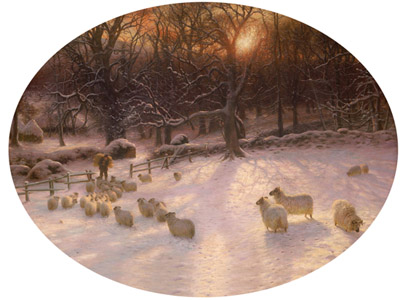
Wherein our Savior’s birth is celebrated
The bird of dawning singeth all night long
And, then, they say, no sprite can walk abroad
The nights are wholesome; then no planets strike
No fairy takes, nor which hath power to charm
So hallowed and so gracious is the time.
(Shakespeare, Hamlet Act 1, Scene 1)
Christmas Eve, the holiest night of the year, is a night of marvels and miracles. Evil is said to lose its power: Witches and sorcerers can cast no spells, fairies and other preternatural beings have no power to lead man astray, and evil spirits are forbidden to walk the earth. Indeed, babies born on this day are considered especially blessed, and those who die at the holy hour of Midnight are said to enter straight into Heaven.
To obtain all of the blessings of this most sacred night, Catholics rose before dawn and cheerfully began the preparations for the day. (1)
The animals’ feast
The animals, those first adorers of the Christ Child in the stable, were attended to with special care on Christmas night. They often received a double portion of their normal feed. In some countries no one was permitted to eat of the Christmas feast until all the domestic animals were fed. Sometimes the animals received a portion of the Christmas meal itself: the first portion of kutia, the first slice of Christmas loaf, etc. (2)
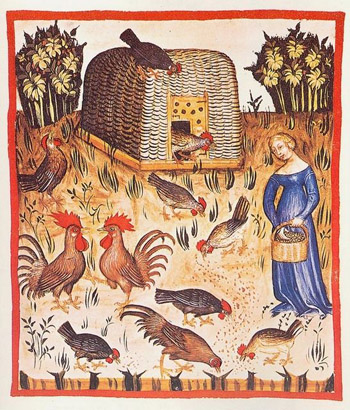
The animals receive extra portions on Christmas Eve
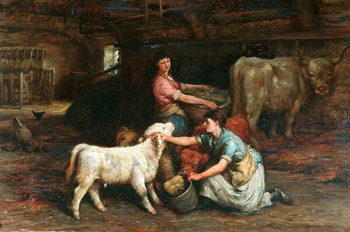
The cattle were especially honored. In some Hungarian villages, farmers fed their cows pieces of the cherished Christmas wafer, and Greek housewives gave them the ground crumbs of special buns made from the Christmas loaf dough. (4) Norwegian peasants greeted their cows with, “Eat and drink, my good cow. Our Lord is born tonight”. (5)
Animals were not only well fed, but also well housed in scrupulously cleaned barns and barnyards in honor of the poor stable that housed the Holy Family on that sacred night. Even the wild animals were given special protection, for all traps and snares were removed from forest and glen and every man put away his gun, bow and hunting knife during this sacred time.
The birds that sang so sweetly for Our Infant King were also remembered in the cold Northern countries and France, where sheaves of wheat and oats were hung on the eaves of houses so that they might be well fed for Christmas. Norwegians tied their sheaves to the top of tall poles made of spruce trees erected in the center of their yards. (6)
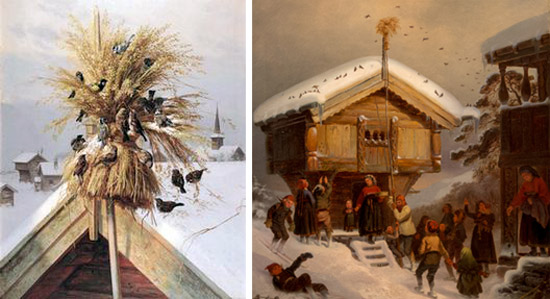
Sheaves of grain tied to fences & rooftops for the birds in Scandinavia
Blessings for the land
The orchards also shared in the blessings of the Holy Night. Many fathers went to the orchards to “waken” the trees in the dark hours of Christmas night either before or after Midnight Mass. In Poland, the father tied stalks of grain from the Christmas decorations around the trees and knocked on them three times saying, “Do you not hear? The Son of God is born.” (8)
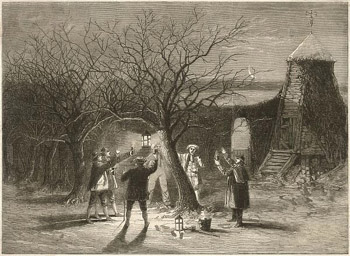
Wassailing the trees
The night before Christmas Eve, Rumanian housewives followed their husbands into the orchards carrying the dough that would make their traditional Christmas cake, the turta, to perform a special ceremony to bring the blessing of fruitfulness. The husband stood before every tree in the orchard and threatened to chop it down; then the wife took her place before the tree and pleaded, “Spare this tree, for next year it will be as heavy with fruit as my hands are with dough.” (11)
Many English farmers wassailed their apple orchards either on Christmas Day or the Twelfth Night by pouring cider over their roots, beating the trunks with sticks and singing special songs. As the trees were wassailed, the people shouted, blew horns, and danced around the orchard as they prayed for a blessed apple harvest in the coming year.
In Medieval England, grain was laid out of doors on this night to be blessed by the dew believed to be the dew from Heaven, that same dew for which Catholics had so fervently prayed throughout Advent: “Drop dew, ye heavens, from above, and let the clouds rain the Just One.” (12)
Indeed, at Midnight the world would see the “Just One” drop down from Heaven, and the arrival of this hour would bring unheard of wonders that would extend the Christ Child’s blessing even further than the orchards and stables.
Continued
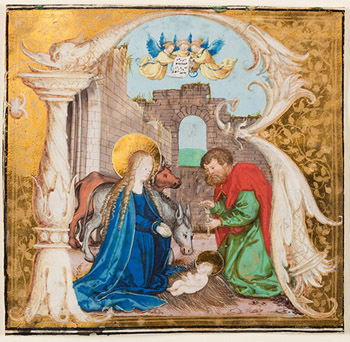
Medieval Nativity with ox and ass
- Sophie Hodorowicz Knab, Polish Customs, Traditions, and Folklore (New York: Hippocrene Books, 1996), p. 30.
- Madeleine Pelner Cosman, Medieval Holidays and Festivals: A Calendar of Celebrations (New York: Charles Scribner’s Sons, 1981), p. 97.
- http://www.myczechrepublic.com/czech_culture/czech_holidays/christmas_superstitions.html
- George A. Megas, Greek Calendar Customs (Athens: B. and M. Rhodis, 1963), p. 29.
- Sigrid Unset, Happy Times in Norway (London: Wyman & Sons Ltd., 1943), p. 15.
- P. Pringle and Clara A. Urann, Yule-tide in Many Lands (Boston: Lothrop Lee and Shepard Co., 1916), p. 81
- https://www.arcanum.com/hu/online-kiadvanyok/MagyarNeprajz-magyar-neprajz-2/vii-nepszokas-nephit-nepi-vallasossag-A33C/szokasok-A355/jeles-napok-unnepi-szokasok-A596/december-A912/december-24-karacsony-vigiliaja-adam-eva-napja-A9B2/karacsonyi-asztal-A9B3/
- Sophie Hodorowicz Knab, Polish Customs, p. 41.
- Mary P. Pringle and Clara A. Urann, Yule-tide in Many Lands (Boston: Lothrop Lee and Shepard Co., 1916), p. 98.
- George A. Megas, Greek Calendar Customs (Athens: B. and M. Rhodis, 1963), p. 30.
- Ann Ball, Catholic Traditions in Cooking (Huntington, Indiana: Our Sunday Visitor, 1993), p. 26.
- https://www.hymnsandcarolsofchristmas.com/O_Tannenbaum/03-The_Fir_Tree.htm

Posted January 3, 2024
______________________
______________________
 |
 |
 |
 |
 |
 |


